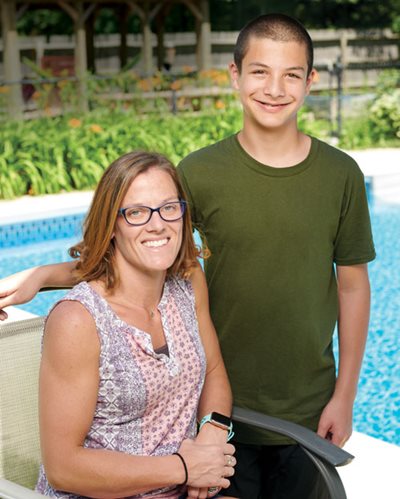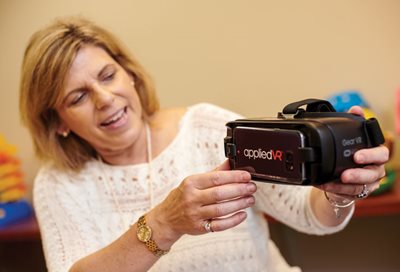When Jack Sloboda recently headed into an Emerson operating room to have a procedure performed, his parents had one worry: the needle that would be required to administer anesthesia. Once a member of the hospital’s Pediatric Intervention Team arrived, it was clear the family, who live in Littleton, had no worries. Their 11-year-old son was soon wearing virtual reality goggles and enjoying an interactive video — with no thoughts of that needle.
 Kristen Sloboda, Jack’s mother, was surprised when she learned that her son’s ear tubes would need to be surgically removed. “Jack had ear tubes inserted when he was a baby, because he had repeated ear infections, as well as difficulty hearing,” she explains, noting that they were effective in preventing his recurrent infections by helping to drain fluid from the middle ear.
Kristen Sloboda, Jack’s mother, was surprised when she learned that her son’s ear tubes would need to be surgically removed. “Jack had ear tubes inserted when he was a baby, because he had repeated ear infections, as well as difficulty hearing,” she explains, noting that they were effective in preventing his recurrent infections by helping to drain fluid from the middle ear.
Those ear tubes fell out on their own, but the more recent pair became firmly wedged in place. “Dr. Setlur told us that the safest way to remove them would be surgically,” says Ms. Sloboda, referring to Jennifer Setlur, MD, a pediatric otolaryngologist who is affiliated with Massachusetts Eye and Ear and performs surgery at Emerson.
The Slobodas did their best to prepare their son for the procedure, which would begin with a pediatric nurse inserting an intravenous needle for the administration of anesthesia. “He had anesthesia before, and I remember feeling him jump during the needle stick,” says Ms. Sloboda. “I was anxious about it, so I was happy to see Vicky Hopley appear with a bag of toys and a blanket for Jack. They really do a wonderful job.”
As a member of the Pediatric Intervention Team (PIT), Ms. Hopley knows how to guide children and families through the hospital experience. “We see every child who comes to Emerson for surgery,” she says. “When a patient is 17 or younger, we call their family prior to surgery and ask, ‘What can you tell us about your child so that we can best support you while you are here?’ It’s an important connection.”
Ms. Hopley was aware that the Slobodas were concerned about Jack having a needle stick, so once he was playing with his age-appropriate bag of toys — known as coping kits — she took the next step. “I need a way to connect with a child, so I asked Jack what he likes to do, and he mentioned video games,” she recalls.
Before long, watching seals play
That did it, says Ms. Sloboda. “Vicky smiled and said ‘Let me go get the virtual reality goggles.’ He was really excited about it.” Ms. Hopley [pictured below] returned with the goggles and asked Jack to select what he’d like to watch. There is a variety of videos, including games.
 “I picked the seals,” Jack says. “I watched seals in a pool, and I went under water and above the water while the seals played.”
“I picked the seals,” Jack says. “I watched seals in a pool, and I went under water and above the water while the seals played.”
The nurse applied numbing cream to his arm, and his parents looked on as the needle was inserted. “He was completely unaware of the needle,” says Ms. Sloboda. “We were so pleased, because we knew that would be the worst part of the whole experience.”
When the virtual reality goggles came off, Jack had his own reaction. “I said, ‘They did it already? But I didn’t feel anything,’” he recalls. “It was so much easier than I thought it would be.”
According to his mother, it was smooth sailing from there. “Dr. Setlur removed the tubes successfully, Jack felt great, and we were home in about an hour and a half,” she says. Needless to say, her son has good memories of his trip to Emerson.
“That is the goal,” notes Ms. Hopley. “I’m impressed at what a wonderful distraction this technology is for children. Since the virtual reality goggles debuted at Emerson earlier this year, we’ve seen how some children enjoy watching videos that show animals, some want to play games, and teenagers seem to like watching ocean waves for relaxation.”
With the procedure behind him, Jack had his own goal. “I begged my parents to buy me a virtual reality headset,” he says. “And they did.”
Helping children and families through a trip to the hospital
The Pediatric Intervention Team can be found wherever children and teenagers receive care at Emerson, including the Emergency Department, diagnostic imaging and the Wheeler 4 pediatric unit. But their presence is especially important in the Clough Surgical Center, a place where children and their parents can spend some nervous hours.
The PIT members know exactly how to distract children with play to create a friendly atmosphere. The team is comprised of a pediatric psychiatric nurse practitioner and two child life specialists, who specialize in helping children and families cope with the challenges of hospitalization, illness and disability. They also work with children who have a family member diagnosed with a terminal illness.
Parents with a child who is scheduled to have surgery at Emerson can arrange pre-operative teaching, which is designed to acquaint the child and the parents with what to expect. To learn more, please call 978-287-3422 to speak with a member of Emerson’s Pediatric Intervention Team.

